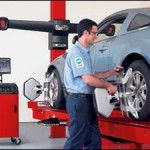 The word “alignment” has many meanings: there’s wheel alignment, body alignment, road alignment, and many other kinds of alignment. But when the word is used in the field of education, that should be a red flag to educators and parents. Beware! Usually the word is used in reference to the curriculum at different age and grade levels. For example, you might encounter a phrase like: “aligning early childhood education and third grade standards.” What this means is that educators are seeking to take the early childhood curriculum and make it look more like the third grade curriculum. In other word, they intend to cripple the sound developmental focus of our preschools, kindergartens, and primary schools, and turn these programs into academic factories.
The word “alignment” has many meanings: there’s wheel alignment, body alignment, road alignment, and many other kinds of alignment. But when the word is used in the field of education, that should be a red flag to educators and parents. Beware! Usually the word is used in reference to the curriculum at different age and grade levels. For example, you might encounter a phrase like: “aligning early childhood education and third grade standards.” What this means is that educators are seeking to take the early childhood curriculum and make it look more like the third grade curriculum. In other word, they intend to cripple the sound developmental focus of our preschools, kindergartens, and primary schools, and turn these programs into academic factories.
Sometimes a phrase is used such as “aligning the preK-16 curriculum.” This is even more serious. It means making preschools and kindergartens line up with the curriculum all the way to the last year of a four year college. I’m even starting to see sites dedicated to preK-20 alignment! These projects are intended essentially to construct a “curriculum superhighway” from the earliest years of life to the last year of graduate school. That is kind of scary. We all know that superhighways tend to be efficient and boring. You get from one point to another quickly. But you miss seeing the countryside, the picturesque towns, the local populace.
This is what preK-20 alignment really means. It means missing what is unique about each stage of life: the need for play in preschool and kindergarten, the hunger for elementary school students to learn as much as they can about the world around them, the proclivity for junior high school students to learn more about their own feelings and identities, the need for high schoolers to start thinking about living as an independent adult out in the real world.
Instead, this whole alignment nonsense shoves all that aside and says “we’re going to get serious right from the beginning of preschool with academics, lecture, workbooks, standardized testing and homework, so that we can prepare students to sit in large auditoriums in college taking notes from a graduate school teaching assistant who would rather be working on his dissertation!”
We need to unmask the word “alignment” and reveal it for the naked power grab that it really represents: the decimation of the innocence of early childhood, the stifling of the curiosity of elementary school students, the strangling of the passion of middle school and junior high school students, and the cutting short of the lofty dreams of high school students. In its place, so-called education “reformers” are building one colorless straight and narrow highway with all the potholes, rest-stops, souvenir stands, charming villages, humorous billboards, and gorgeous natural scenery–in other words, all the joy of the journey of life–taken out. Let’s stop this madness. Whenever you hear or read this word “alignment” in reference to schools and the curriculum, speak out against these architects of mindless, souless efficiency in our schools.
Note: To read more about what students’ real developmental needs are in school, see my article “The Curriculum Superhighway” in Educational Leadership, and my book The Best Schools: How Human Development Research Should Inform Educational Practice(published by ASCD).
This article was brought to you by Thomas Armstrong, Ph.D. and www.institute4learning.com.
Follow me on Twitter: @Dr_Armstrong



















